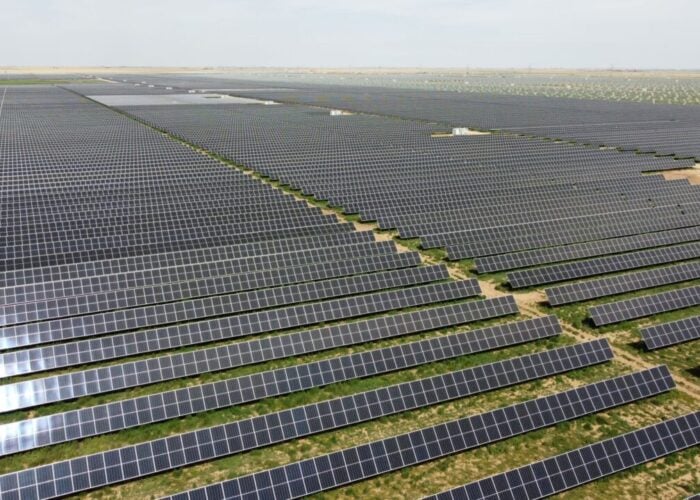
A team of researchers from Dartmouth College and Princeton University in the US have released a report into the potential financial benefits of the Inflation Reduction Act (IRA) on the US renewables sector, with solar projects able to cut the cost of producing electricity by up to 60%.
The report, which was funded by the BlueGreen Alliance, a group representing the interests of US labour unions and environmental organisations, was initially published last Friday, and was updated on Monday (12 June). A key takeaway from the report is that projects receiving the clean energy production tax credit (PTC) could see their exemptions from taxes increase considerably.
Unlock unlimited access for 12 whole months of distinctive global analysis
Photovoltaics International is now included.
- Regular insight and analysis of the industry’s biggest developments
- In-depth interviews with the industry’s leading figures
- Unlimited digital access to the PV Tech Power journal catalogue
- Unlimited digital access to the Photovoltaics International journal catalogue
- Access to more than 1,000 technical papers
- Discounts on Solar Media’s portfolio of events, in-person and virtual
Or continue reading this article for free
“The study reveals how the IRA transforms the economics of wind and solar power to help delink our climate goals from overseas supply chains that are marred by labour abuses, higher levels of pollution and shipping bottlenecks,” said BlueGreen Alliance vice president of manufacturing and industrial policy Ben Beachy. “Instead, these new investments offer an opportunity to build our clean energy future on a foundation of good jobs, clean manufacturing and a more reliable and equitable industrial base.”
The PTC is a core component of the IRA, offering tax relief for projects built before the end of 2033, or the point at which US power sector emissions fall to 25% of 2022 levels, and produce clean power. New and existing renewable energy projects can apply for the PTC, and apply for what the researchers call a “base” tax credit of US$0.0055 per kWh produced.
A project can additionally apply for what the researchers call a “bonus” tax credit that is five times greater, equal to US$0.0275 per kWh produced, and can receive this bonus credit if construction is completed by qualified apprentices and labourers that are paid what the researchers call “prevailing wage rates” for their work.
Such projects can also apply for a further “tax credit adder” of 10%, if an energy project meets what the researchers call “domestic content requirements or qualify as an energy community”, further incentivising the production of renewable power in and for the benefit of the US.
As a result of these conditions, companies that qualify for the bonus tax credit could see the levelised cost of electricity (LCOE) generated by clean power fall by as much as 60% compared to clean energy facilities not covered by this tax break. A project that qualifies for all of these tax benefits – the PTC, the bonus tax rate and both elements of the tax credit adder – could see its LCOE fall even further, from a baseline of between US$22-US$23 per MWh for utility-scale solar to US$2-US$6 per MWh.
Manufacturing and employment benefits
There are also benefits for the solar manufacturing sector. The 45X advanced manufacturing production tax credit will reduce the cost of producing solar panels, with the researchers estimating that solar modules made in the US, and made from components produced in the US, will be 30% less expensive to produce than imported modules, a state of affairs that will encourage domestic solar production.
“Using US-manufactured parts and materials for clean energy development and paying workers a fair wage has always been the right thing to do. Now it’s also the most economical thing to do,” said BlueGreen Alliance executive director Jason Walsh. “This report shows that the IRA successfully creates an air-tight business case for supporting US workers and manufacturers.”
The IRA could also help generate demand for 1.7 million jobs across the US utility-scale solar sector by 2035, including 850,000 jobs in component manufacturing and 800,000 jobs in construction and operations. Both of these figures are higher than the researchers’ estimates for new wind jobs, as the increased demand for US-produced solar infrastructure helps create new jobs across the supply chain.
However, the researchers have significantly scaled-down their estimates for the number of jobs created by the IRA in the past few days. The initial version of the report estimated that the act would help create 4.5 million jobs in US utility-scale solar, including 2.6 million in component manufacturing and 1.9 million in construction and operations.
The report’s authors note that the work has been published “in the spirit of a working paper to enable timely consideration, discussion and feedback,” and has not yet been subjected to formal peer review. This highlights some of the challenges associated with forecasting figures in a sector as new and prone to change as the solar industry, so while the broad conclusions of the report are encouraging, some of the finer details may be less definite.
The news follows the best-ever first quarter for US solar growth, as companies across the sector look to take advantage of favourable investment conditions created by the IRA.







